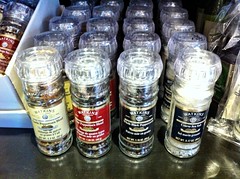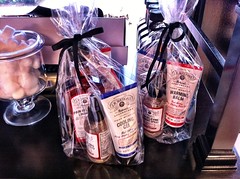| English: the administration building designed by George W. Maher for the J. R. Watkins Company (Photo credit: Wikipedia) |
The Early History of Watkins
Last Updated on Saturday, 29 November 2008 11:50 Written by John Wednesday, 20 August 2008 10:11
The Birth of Watkins
Watkins Incorporated was founded in 1868 by Joseph R. Watkins in Plainview, Minnesota. Mr. Watkins started Watkins with a single product, Dr. Ward's Red Liniment, using a formula he purchased directly from Dr. Ward, the inventor of the liniment product.J.R. Watkins was an entrepreneur that went on to build a fortune selling liniment and numerous products he created later. He was not a doctor, but instead an entrepreneur and believer in the power of herbs to treat and cure many common ailments of the day.
| J.R. Watkins (Photo credit: AngryJulieMonday) |
One only has to study why J.R. Watkins moved his thriving liniment business from Plainview, Minnesota to Winona, Minnesota to realize why he was so successful early on. In the 1870’s, Winona had 20,000 residents, a big city for those days, and was home of a huge lumbering business, being based on the Mississippi River. Winona also had 5 railroads that when through the city. Most of the workers in Winona worked at the lumber mills or worked as lumberjacks.
Talk about “Liniment Heaven!” Can you imagine how many men went home every night with muscle aches and pains? And J.R. knew his product would work. He also knew that it took a few days for the liniment to kick in and produce wonderful, powerful results. J.R. believed in his liniment’s powers and abilities so much that he placed a trial mark line on every bottle, and told every new customer that every drop liniment from the top of the bottle down to the trial mark line was basically free, because if they didn’t go below the trial mark he would give them a 100% refund of their money if they were not satisfied with the product after giving it a try. For J.R. knew that before the customer would get to the trial mark, their aches and pains would have gone away. Now how’s that for marketing innovation?
Watkins Grew Rapidly in the Early 1900's
At its peak in the door-to-door sales era, Watkins had 135 counter stores in the U.S. and Canada, along with manufacturing and distribution centers outside North America in South Africa, New Zealand and Australia. With his widespread success, Mr. Watkins became an icon in his time. He traveled the globe in search of the purest and finest sources of herbs, pepper, cinnamon and other spices for his product line, just as the company still does today. For example, Watkins vanilla comes vanilla beans grown in Madagascar, the same as it has been for over 100 years.
Watkins, the company, grew rapidly in the early 1900’s and by the 1930’s was the largest direct sales company in the entire world. In fact, during the Great Depression years of the 1930’s Watkins actually grew in size, adding infrastructure, new regional facilities and most importantly, adding new jobs. In fact, as a result of its success during the depression, the public labeled Watkins a “depression proof company.“
| J.R. Watkins (Photo credit: AngryJulieMonday) |
Birth of the "Watkins Man"
Watkins was founded on the “door-to-door” direct sales model. J.R. Watkins started delivering liniment door-to-door by wagon. The door-to-door model worked successfully for almost 90 years. With the exception of the World War years, most housewives could be found at home, not at work. Thus, there was usually always someone at home to call on during the daytime hours. This was long before the arrival of personal computers, so online sales were out of the question. America did not outsource its labor-intensive jobs to foreign countries. Manual labor could be found everywhere you went, particularly in rural areas. Thus, the door-to-door, farm-to-farm, plant-to-plant sales model was an ideal way to market Watkins products.Mr. Watkins company was not only the first international direct sales company in the world, but for many years it was the largest direct sales company in the world. His direct sales force grew to become an American institution. “Watkins men” became part of Americana, transcending from selling Watkins products from wagons in the 1800’s to selling Watkins products from paneled trucks, vans and station wagons in the 1900’s.
I can recall when growing up in rural Louisiana our Watkins man having a large black leather products case with the Watkins label in gold letters on the outside of his case. The case opened up like a large tackle box with multiple shelves. Looking into that case each month was like gazing under the Christmas tree on Christmas morning.
The “Watkins man” brought more than products to his customer base. In the early days he was one of the few forms of communication in rural America, relied upon for bringing the latest news about national and world events, the going price for wheat or corn on the commodity exchange, the latest storms to hit the area, etc. It was a different world -- one that would eventually change and have a dramatic impact on the company and its future.
The Death of J.R. Watkins
Mr. Watkins died in 1911 while vacationing with his family in Jamaica. He and his first wife Mary Ellen, who had preceded him in death in 1904, had two sons that died at very young ages, and one daughter, Grace, who was born in 1877. Grace was approximately 34 at the time of J.R. Watkins death and his only living child. Grace immediately became the largest shareholder in Watkins. Control of the company passed on to his nephew, Paul Watkins, and his son-in-law, Ernest Leroy (E.L.) King Sr., who married Grace in 1904. Paul Watkins was a graduate of Harvard, very bright and articulate, and became President of Watkins after J.R. Watkins death.Watkins Naturals
http://www.watkinsnaturals.com








No comments:
Post a Comment
Please leave a comment, question, and or your own resource.
(Comments, questions, or resources must be relative to post) Thank You